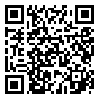Volume 11 - Articles-1400
MEJDS (2021) 11: 170 |
Back to browse issues page
Download citation:
BibTeX | RIS | EndNote | Medlars | ProCite | Reference Manager | RefWorks
Send citation to:



BibTeX | RIS | EndNote | Medlars | ProCite | Reference Manager | RefWorks
Send citation to:
Askari F, Manavi Pour D. Designing a Model of Therapeutic Alliance with Self-Differentiation in the Clients of Counselling Centers. MEJDS 2021; 11 :170-170
URL: http://jdisabilstud.org/article-1-2106-en.html
URL: http://jdisabilstud.org/article-1-2106-en.html
1- Department of Psychology, Faculty of Psychology and Educational Sciences, Garmsar Branch, Islamic Azad University
Abstract: (605 Views)
Background & Objectives: Numerous experts believe that an essential key to the success of treatment is the conclusion of a therapeutic alliance in the treatment process. Mental health professionals have long recognized that different psychotherapy methods share the main elements. The therapeutic alliance is the most influential variable in the treatment process and the best predictor of therapeutic outcome. The concept of therapeutic alliances has historically emerged from the literature of psychodynamic research; however, it is considered essential in various psychological approaches. One consistent finding in recent research related to psychotherapy is that the quality of therapeutic alliance is a strong predictor of treatment outcomes in multiple approaches. Accordingly, a poor therapeutic alliance is associated with the client's treatment abandonment. Personality traits of individuals play an important role in the client–therapist relationship. Thus, another crucial characteristic in the client–therapist therapeutic alliance is the degree of differentiation of the client. The current study aimed to design a therapeutic alliance model and determine its relationship with its differentiation among counseling clients.
Methods: This was a descriptive and correlational study. The statistical population of this study included all clients with psychological and behavioral problems in Tehran City, Iran, referring to counseling centers in 2017 and 2018. Initially, Tehran was divided into north, south, east, and west regions. Moreover, 3 counseling centers whose managers were willing to cooperate were selected from each section. Next, by referring to counseling centers and information about the total number of clients per year in 2017 and 2018 (i.e., estimated to be 1700), using Morgan's Table, the sample group consisting of 200 male and female references were randomly selected, consisting of 145 females and 55 males in the age range of 19 to 51 years. They also presented no history of drug use or stroke and had at least a diploma. The California Psychotherapy Alliance Scale (Gaston and Marmar, 1994) and Self–Differentiation Inventory (Skowron & Schmitt, 2003) were applied to collect the required data. The conceptual model of the research was presented based on Horvath conceptual model (1981). Descriptive statistics, including mean and standard deviation and Tables were used in SPSS to present the collected data. To test the proposed research model, the structural equation modeling was applied AMOS at a significance level of 0.01.
Results: By performing the fitting of the final model, the fitting indices were calculated for the Chi–squared (CMIN=3.50) with the value of the Comparative Fit Index (CFI=0.907), respectively. Besides, the Root Mean Square Error of Approximation (RMSEA=0.072) was obtained, indicating that the final model had a good fit. Furthermore, the model was generally confirmed. The obtained results also outlined a relationship between therapeutic alliance and self–differentiation (Beta=0.28, p=0.019).
Conclusion: Based on the present study findings, the therapeutic alliance model designed in this study and its relationship with self–differentiation in counseling center clients indicated a good fit; thus, using this model will help counselors consider more appropriate treatment for clients.
Methods: This was a descriptive and correlational study. The statistical population of this study included all clients with psychological and behavioral problems in Tehran City, Iran, referring to counseling centers in 2017 and 2018. Initially, Tehran was divided into north, south, east, and west regions. Moreover, 3 counseling centers whose managers were willing to cooperate were selected from each section. Next, by referring to counseling centers and information about the total number of clients per year in 2017 and 2018 (i.e., estimated to be 1700), using Morgan's Table, the sample group consisting of 200 male and female references were randomly selected, consisting of 145 females and 55 males in the age range of 19 to 51 years. They also presented no history of drug use or stroke and had at least a diploma. The California Psychotherapy Alliance Scale (Gaston and Marmar, 1994) and Self–Differentiation Inventory (Skowron & Schmitt, 2003) were applied to collect the required data. The conceptual model of the research was presented based on Horvath conceptual model (1981). Descriptive statistics, including mean and standard deviation and Tables were used in SPSS to present the collected data. To test the proposed research model, the structural equation modeling was applied AMOS at a significance level of 0.01.
Results: By performing the fitting of the final model, the fitting indices were calculated for the Chi–squared (CMIN=3.50) with the value of the Comparative Fit Index (CFI=0.907), respectively. Besides, the Root Mean Square Error of Approximation (RMSEA=0.072) was obtained, indicating that the final model had a good fit. Furthermore, the model was generally confirmed. The obtained results also outlined a relationship between therapeutic alliance and self–differentiation (Beta=0.28, p=0.019).
Conclusion: Based on the present study findings, the therapeutic alliance model designed in this study and its relationship with self–differentiation in counseling center clients indicated a good fit; thus, using this model will help counselors consider more appropriate treatment for clients.
Type of Study: Original Research Article |
Subject:
Psychology
Send email to the article author
| Rights and permissions | |
 |
This work is licensed under a Creative Commons Attribution-NonCommercial 4.0 International License. |



